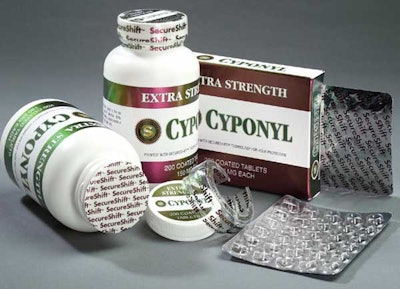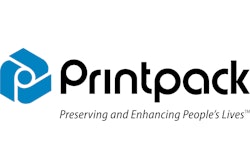Packaging security programs that work attack the issue on two fronts. First, they make packaging managers address security from a strategic viewpoint. Then, they make those managers
find the right technologies, focusing on methods that fit a company’s specific needs.
That’s the view held by a number of consultants and industry leaders who are helping packagers develop answers to security threats.
“The two biggest tools are devices and people,” says David Phillips of Axess Technologies Ltd., a Boston- and U.K.-based
consulting firm that focuses on security. “The goal is to have secure packaging that protects the product’s quality. That requires security systems on the packages themselves and security for packaging operations.” Operational security focuses on people. Operational security needs to look at who knows about security measures and who is handling packages with secure features.
Counterfeiting is high on the list of security concerns. Drugs, distilled spirits, and cosmetics face the greatest threats. But other high-value packaged items are targets, too. The British think-tank PIRA estimates that economic losses from counterfeiting increased to 10% of world commerce in 2003; those losses are a key reason for the intense focus on anti-counterfeiting steps.
Carolyn Burns of DuPont Security&Solutions says packagers have to have a security strategy to meet the threat. “It needs to be channel management. You have to look at the primary container, the box, the pallet, and the truck. Brand owners are looking for a layered approach—they want several levels of security,” Burns says.
She recommends the following checklist of questions to guide packagers in developing a security strategy:
1. Which products are involved or have been attacked in the past and present?
2. Where is the problem, geographically? (One of the best sources is the brand owner’s field sales force. “The brand owner’s sales people in a territory will be the first to know if there is a problem. They will see it first if sales fall, and they will see it on store shelves,” observes Burns.)
3. Have security features been used previously?
4. Were they effective and for how long?
5. Is the nature of the threat likely to change?
6. What are the estimated losses to revenue?
7. What additional liabilities are at stake, including brand integrity and possible litigation?
8. Can a return on investment be calculated for added security features on a package?
Ed Bauer, director of global packaging for Bausch & Lomb, emphasizes that doing such an assessment is more than a one-time event. He believes that once you have committed to a security program, you have to commit to constantly changing the technologies you use to provide security. That is particularly true for a security program that focuses on counterfeiting.
“It is the marketing people that have to come to grips with this,” Bauer says. Yet he agrees that packaging managers have to be technologically savvy in executing a program.
Consultant Stan Hart, president of S.G. Hart & Associates, Ridgefield, CT, sees packaging as a key tool in executing
anticounterfeiting programs.
“Packaging is one of the economical points to apply anticounterfeiting devices,” he explains. “You have to use multiple techniques, and you have to keep changing them. Viagra, for example, has a multitude of security devices.”
Packaging is the right place to incorporate anticounterfeiting techniques because it allows packagers to vary techniques. This concept of changing techniques to stay one step ahead of counterfeiters is central to the strategy outlined by the Food and Drug Administration for security of pharmaceuticals.
“You have to look at how you manufacture your product. You want any anticounterfeiting device to be as close to your customer as possible. If you can do something on your packaging line just before it leaves your facility, that’s where it is easiest to make changes,” Hart says.
If a security device is applied too early in the production/packaging process, it requires more effort to change it and hampers a packager’s ability to vary techniques. It gives counterfeiters a greater opportunity to copy a security technique because they may be able to get security components in the supply chain before they reach the packager’s operation.
“Sometimes the source of the problem can be your suppliers. You can destroy rejects on your line, but who is to say the supplier hasn’t run an extra 400ꯠ cartons? The problem has become greater with overseas outsourcing,” Hart explains.
The emphasis on cost reduction opens security issues. He notes that an order for packaging materials—cartons, for example—may be put out to bid to as many vendors as possible to ensure the lowest cost. “If you ask for samples and provide prospective vendors with the substrates you are using, the inks you are using, and the digital files for your package, then you have increased the chance for a security breach,” Hart explains. “When you implement a security program you have to control the materials involved,” he says.
Phillips of Axess Technologies says to be especially cautious with overseas outsourcing. “Security and outsourcing to the Far East aren’t compatible,” he says.
Technology answers
Among technologies responding to threats of counterfeiting are taggants. These are substances added to inks, adhesives, or even the packaging substrate itself. In essence, a taggant creates a “fingerprint.” If the fingerprint is missing, or if it doesn’t match what the packager put in the package, then the package is a counterfeit. Taggants fall into the category of security technologies known as covert because they are hidden from casual observation.
An emerging category of taggants is the DNA marker. The chief advantage of DNA markers is that they are virtually impossible to duplicate. Applied DNA Sciences of Los Angeles engineers a powder based on modified plant DNA; it has a complexity that makes it all but impossible to duplicate. The powder is in a microcapsule, small enough to mix into packaging components such as inks, press varnish, or adhesive on the manufacturer’s joint of a carton.
Verification of a DNA marker from Applied DNA Sciences is a two-step process. Presence or absence of the marker can be done with a portable kit in the field. Swabbing the package with a reagent quickly verifies that the DNA is present. But to verify that it is the specific DNA that a packager put into the package requires that the package be sent to the lab at Applied DNA Sciences. There, a sophisticated analysis verifies that it is the specific DNA incorporated into original packages.
Use of such a technology underscores the need to have a strategy in place, explains Jim Rogers of Flint Ink. “You have to ask yourself such questions as, ‘Am I going to have people pull product off store shelves and test them?’ Or, ‘Do I need to send them to a lab for forensic testing?’ Strengths and weaknesses in the technologies depend on what the brand holder intends to do with them. It’s not a matter of buying technology. It is a matter of having a strategy and using the technology that fits the strategy,” he explains.
Packagers have to closely guard whatever authentication
technique they use. “Counterfeiters need to know where to look to duplicate the anticounterfeiting technique,” explains Rogers. “So, if you have a taggant in an ink and keep that confidential, the counterfeiter doesn’t know where to look, and it makes his job harder.”
Another technology is color-shifting pigments. In simplest terms, they are microscopic flakes introduced into package components. When viewed from one direction, they appear as one color, but as the package is rotated, they appear to be a different color.
A sample from JDS Uniphase/Flex Products, Santa Rosa, CA, is a rose color when viewed from one angle but green when viewed from another. As an overt security technique, it allows the consumer to visually verify that the package is authentic.
Current uses are in packaging for prescription drugs, and points of use include labels, tamper-evident bands, inner seals, cartons, and the nonforming web on blister packs.
To keep the pigments secure in the packaging supply chain, JDS Uniphase/Flex Products produces the microflakes and also makes the packaging components in which the microflakes appear. That eliminates risks of the anticounterfeiting device being compromised in the supply chain.
Simple Ideas Work, Too
Approaches such as DNA tags and color-shifting pigments represent emerging technologies. However, the layered approach to security also includes nitty-gritty tactics such as case tape and tamper-evident bands. They are as much a part of packaging security as the more exotic approaches.
Hormel Foods, like many food manufacturers, has to incorporate tamper evidence in packages, yet has to do it as economically as possible. One instance is the 25-count package of Herb Ox bouillon cubes.
The package is a high-density polyethylene jar with a screw cap. Hormel gets tamper evidence by using a PVC shrink label on the jar and extending it up over the closure.
“By applying the shrink sleeve over the closure,
we get both tamper evidence and decoration,” notes Hormel’s Brand Lindberg. “We could certainly apply a different style label with a separate tamper-evident band, but in the long run, this is the most cost-effective.”
The rotogravure-printed sleeves from Seal-It allow Hormel to carry promotional messages up over the cap. The messages vary, giving Hormel promotional opportunities. The sleeve’s gloss also adds to shelf impact.
Better Packages, Shelton, CT, has a case tape printing system that incorporates both visible and invisible security components. The taper can put a company name in human-readable code on a case-sealing tape, making it harder for a casual thief to open a case, remove contents, and then reseal the case.
However, the system also imprints a code in a security ink
that can be read only under a UV light. That adds one more layer to the case’s security.
No matter which technique a packager selects, it is more effective when teamed with additional technologies to create layers of security. And the “how” of package security must be matched with a management strategy that keeps it a priority for packaging.





























